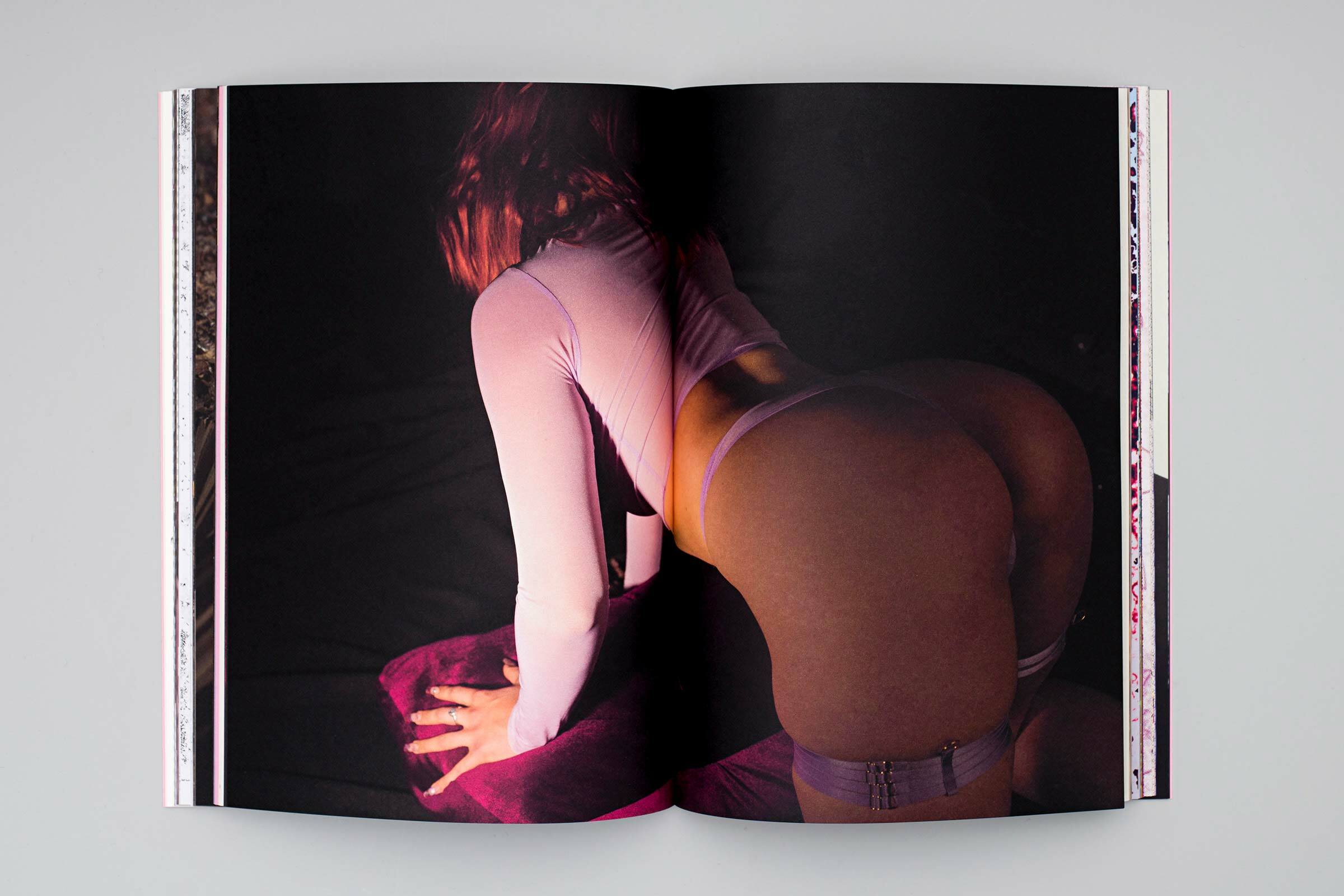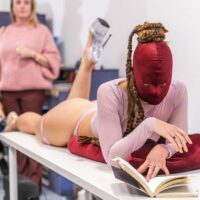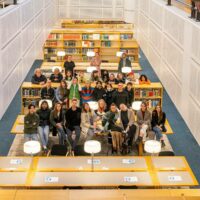NLN x KB - How Would You Like to Get Lampooned, My Lord?
Students of the Master Non Linear Narrative collaborated with KB, the National Library of the Netherlands in The Hague, to scrutinise the book as a publishing platform and create new, compelling narratives that link the alba amicorum (friendship books) to immediate issues affecting us today.
The publication “How Would You Like To Get Lampooned, My Lord?” brings together the voices of 10 young designers covering topics like privilege, gender discrimination, colonialism and institutional archiving practices.

Students of the programme visited on 28 March 2022 Amsterdam-based printing company robstolk to learn first-hand everything about bookmaking. Here, printed matter is produced with great accuracy and relentless attention to details.
Miriam Suijkerbuijk and Tanneke Janssen from robstolk welcomed the students and gave a comprehensive tour through the facilities. After that, Sofie Jacobs, paper consultant at Papyrus, and Patrick Bakermans, bookbinder at Boekbinderij Brepols, shared their knowledge on paper types and bookbinding techniques.
Visit to robstolk printing company
Spreads of the publication
Content

‘Coreless Fortress’ is a dreamy and endless journey into Burchard Grossmann's first album amicorum (made between 1624 and 1645). The narrative unfolds in an allegorical route, capturing the author’s attempt to find an object of attention in the album amicorum, and failing to find any graspable substance in it. Like a mask, they show as much as they hide. ‘Coreless Fortress’ discusses the absurdist character of an object that functions in a vacuum as an endless loop of reproducing privilege.

‘The Name Is Not Mentioned’ highlights the scarcity of information available about the women of the alba amicorum collection. This series of images was created by mapping two-dimensional images onto three-dimensional renders, celebrating the creative potential of this missing information. These visuals create a dialogue between the incompleteness and inherent narratives of cultural artefacts – in this case the alba amicorum – to allow for critical reflection on the shortcomings of historical resources.

At the time, keeping an album amicorum required privilege as these gentile time-passing activities were inaccessible to most. To subvert excessive praise or romanticisation of these books, I invite you to look at them through embracing the idiosyncrasy of a personal narrative. For 'Puncture', I recalled the heavily decorated pages and drew from memory. These incomplete recollections created images that are more personal and autonomous. Boycotting the celebration of people who kept and wrote in alba amicorum for their exceptional achievement in the cultural field and its opulence has merit.

The physical collections of the KB are gradually decomposing over the grand spans of time during which it is kept. Because of this, the KB is digitising their physical collection, formally called dematerialising. Yet, digital data is as much in danger of rotting away as material data. ‘All Rots Bit by Bit’ explores the similar processes of decay of both physical and digital data. Macro photography of damaged pages from the alba amicorum collection are rendered into an increasingly decaying digital landscape, bringing both worlds of decomposition together.

Loss of cultural memory creates a divide between the present moment and the alba amicorum created three or four centuries ago. Jacobus Heyblocq’s album amicorum provides an archive of 10 Dutch cities he visited during his 67 years. I used his traces and memories as a tour guide to explore 10 cities in 16 hours, and ended up collecting abandoned objects such as newspapers, letters, and lottery tickets on the way. I juxtaposed segments of Heyblocq’s album amicorum that visually and contextually corresponded with my collection of abandoned materials, creating so-called hybrids of different eras that represent lost common knowledge.

The visual essay ‘Alba Amiwhora’ responds to the depiction of the Venetian Courtesane in alba amicorum. She stands out amongst the upper-class white men whose books have been carefully preserved. Sex workers are often misrepresented or not represented at all, and historically they are not welcome in institutionalised spaces. For 'Alba Amiwhora', sex worker Kami Million claims her space in this well printed publication. “I want to honour the whores, thanking them all in the past, present and future for the amazing work they do. Showing up in an academic space like this is part of our fight for destigmatisation. Holding space for us to exist is the bare minimum we need.”

How natural are the narratives constructed by the alba when the silverfish – the embodied agents of gentle deterioration and forgetfulness – are deliberately kept from the collection? By keeping out actual natural processes, narratives are slowly yet actively constructed to form a colonial, imperial, and thus unnatural, reality. Using the trapped bodies and remnants of the silverfish caught by the library, this is an ode to the insects: nature’s agents for keeping memory moving. Let them in, let them feast on the collection and let them deconstruct the narratives we so painstakingly attempt to preserve.

‘The Best Selected’ is a visual observation that muses on the question of what deserves to be preserved. Over the centuries, the citrus fruit has been called the 'golden fruit', symbolising money, status, and privilege in the West. By creating a collection of orange wrapping papers, I question why some documents are considered trash and others treasure. Considering a variety of alba amicorum and with a collection of 70 citrus wrapping papers collected during spring 2022, this contribution compares the difference between handling and archiving. What would we discover if we treated our surroundings with as much care as the National Library handles its collection of alba amicorum? How could we learn to recognise the values of objects not being guarded behind closed doors?

In the fifteenth century, the ability to write calligraphy in Latin or Greek showed one’s access to education, power, and time, thus separating them from lower social circles. Excessive aesthetics draw us to alba amicorum, lure the beholder to marvel, and soften the critical gaze that might otherwise notice the lack of artefacts from lower classes. I researched the privileged origins of Gerbrand van den Eeckhout and Claudius Salmasius, linked symbolic items of their background in a three-dimensional space, and placed their names, translated from handwritten to digital bones, on the front. I literally illuminate what is often hidden by calligraphic perfection by placing nepotism, slavery, and capitalist power structures in bright light.

This series of collages emerged from a research project that explores the use of animal imagery in family crests in alba amicorum. On coats of arms, fish signified a true, generous mind; eagles represented a person of noble nature; male animals were considered superior to females. Fast forward to the present: do we not also ascribe our own meanings to animals when using them as avatars or when sending cute animal stickers out to group chats? Could this be considered a form of contemporary totemism? ‘Uncoated. Unarmed’ is a bold and ironic exploration of Them and Us in relation to animal totems of the past and present. The project provokes us to think about how animal imagery has and continues to be in service of human cultures, class identities, and communication.
Credits / thanks to
Students
Lisette Alberti
Lode Dijkers
Leonie Gores
Daniel Gremme
Shouyi He
Alicja Konkol
Eszter Nagy
Camille de Noray
Julija Panova
Karolina Uskakovych
Project Supervision
Linda van Deursen
Mijke van der Drift
Rianne Koning
Katrin Korfmann
Niels Schrader
Jeroen Vandommele
Photographer
Roel Backaert
This project is part of the KABK x KB collaboration within the Open Digital Libraries EU project


